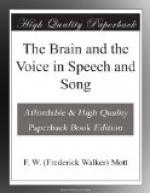The conditions necessary to the existence of speech arose with articulation, and it is intelligence that has converted the vocal instrument into the speaking instrument. For whereas correct intonation depends upon the innate musical ear, which is able to control and regulate the tensions of the minute muscles acting upon the vocal cords, it is intelligence which alters and changes the form of the resonator by means of movement of the lips, tongue, and jaw in the production of articulate speech. The simple musical instrument in the production of phonation is bilaterally represented in the brain, but as a speaking instrument it is unilaterally represented in right-handed individuals in the left hemisphere and in left-handed individuals in the right hemisphere. The reason for this we shall consider later; but the fact supports Darwin’s hypothesis.
Another hypothesis which was brought forward by Grieger and supported by some authors is summarised by Ribot as follows: “Words are an imitation of the movements of the mouth. The predominant sense in man is that of sight; man is pre-eminently visual. Prior to the acquisition of speech he communicated with his fellows by the aid of gestures and movement of the mouth and face; he appealed to their eyes. Their facial ‘grimaces,’ fulfilled and elucidated by gesture, became signs for others; they fixed their attention upon them. When articulate sounds came into being, these lent themselves to a more or less conventional language by reason of their acquired importance.” For support of this hypothesis the case of non-educated deaf-mutes is cited. They invent articulate sounds which they cannot hear and use them to designate certain things. Moreover, they employ gesture language—a language which is universally understood.
Another theory of the origin of the speaking voice is that speech is an instinct not evolved, but breaking forth spontaneously in man; but even if this be so, it was originally so inadequate and weak that it required support from the gesture language to become intelligible. This mixed language still survives among some of the inferior races of men. Miss Kingsley and Tylor have pointed out that tribes in Africa have to gather round the camp fires at night in order to converse, because their vocabulary is so incomplete that without being reinforced by gesture and pantomime they would be unable to communicate with one another. Gesture is indispensable for giving precision to vocal sounds in many languages, e.g. those of the Tasmanians, Greenlanders, savage tribes of Brazil, and Grebos of Western Africa. In other cases speech is associated with inarticulate sounds. These sounds have been compared to clicking and clapping, and according to Sayce, these clickings and clappings survive as though to show us how man when deprived of speech can fix and transmit his thoughts by certain sounds. These mixed states represent articulate speech in its primordial state; they represent the stage of transition from pure pantomime to articulate speech.




